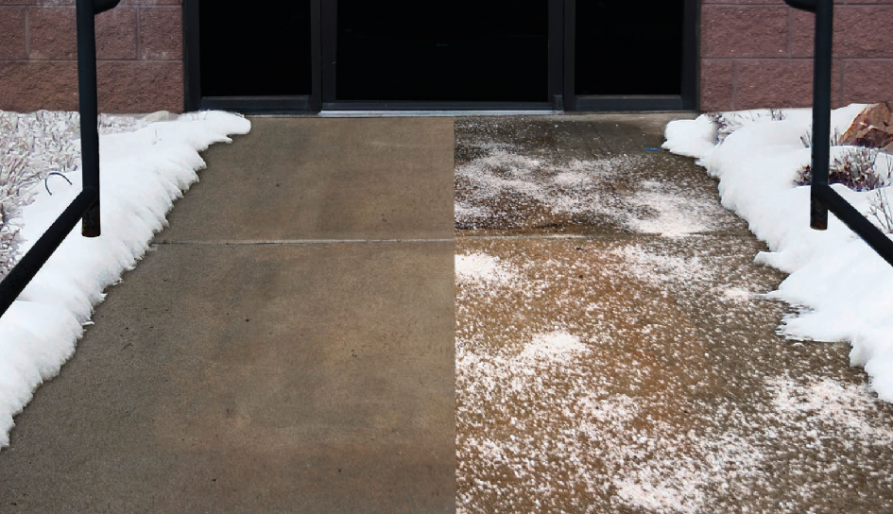Winter conditions can wreak havoc on any environment; but in the case of commercial properties, it can be a downright headache for cleaning professionals. And while there are any number of extra challenges to deal with during Canada’s frosty season, few beat the hassle of cleaning tracks left by guests coming in from the cold.
“From a janitorial perspective, it can be a bit of a nightmare,” says Nate Clemmer, CEO of Secure Winter Products. “When we ask cleaning crews what the worst part of their day is, many of them say it’s dealing with the mess people track in from the snow, which can leave entrance ways, restaurant lobbies, or office floors looking like an old-school chalkboard.”
“It’s not a good first impression,” he adds.
By and large, these visible tracks are a result of using chloride salt de-icing solutions to melt outside ice and snow. Once applied to outdoor walkways and roads, the granular material finds its way through the front doors where it accumulates on interior flooring.
“It’s a big issue for cleaners,” agrees Mark Warner, CMI Education Manager with ISSA Cleaning Management Institute. “When those salts get tracked into a building, that crystalline material can cause damage in the flooring, whether by cutting up the fibers on carpeting, scratching hard surfaces like terrazzo or marble, or attacking the finishes on expensive flooring.”
Moreover, he adds, salt particles can damage cleaning equipment from the inside out, leading to costly repairs and replacements: “We all know how corrosive salt can be. So you can imagine what it does to the inside of $2,000 backpack vacuums and $10,000 automatic floor scrubbers. It just eats them up.”
Safety first
Left unchecked, winter tracks can pose considerable health and safety concerns for building occupants and staff.
“If that material gets tracked in and it’s still in its granular form, it can be like walking across a floor of marbles,” Warner explains. “More importantly, salt-based ice melters are hygroscopic, which means they attract moisture out of the air. So the residues that are on the indoor floor are actually creating an excessive amount of dampness, and because of that, a lot of building owners and cleaners will report that their floors seem excessively slippery.”
New approaches
 The cleaning industry has a knack for solving old problems with fresh innovations. And when it comes to tackling winter tracks, Clemmer and his team at Secure Winter Products have developed one such solution called Entry®, a chloride and residue-free, liquid ice melt product. With a pH value similar to water, Entry® is designed to evaporate rapidly upon use and prevent re-freezing to temperatures below 20°C. This affords cleaning professionals a de-icing alternative that not only works quickly when applied, but doesn’t leave visible tracking and all the issues that come with it.
The cleaning industry has a knack for solving old problems with fresh innovations. And when it comes to tackling winter tracks, Clemmer and his team at Secure Winter Products have developed one such solution called Entry®, a chloride and residue-free, liquid ice melt product. With a pH value similar to water, Entry® is designed to evaporate rapidly upon use and prevent re-freezing to temperatures below 20°C. This affords cleaning professionals a de-icing alternative that not only works quickly when applied, but doesn’t leave visible tracking and all the issues that come with it.
“From both a liability and asset preservation perspective, that’s a big deal,” says Clemmer.
Entry®’s chloride-free formulation makes it particularly appealing to building owners and managers. Over time, chloride salts can cause damage to metals and concrete, as well as pose risk to plants and pets. By contrast, Entry®’s chloride-free composition makes a significantly lower impact on its surroundings. This is particularly important for Canadian cleaning crews who must apply (and re-apply) de-icing products ad nauseam during the long winter seasons, but don’t want to do so at the expense of eroding their natural and physical assets.
Asset protection notwithstanding, Entry®is also readily biodegradable. And as the first ice melt in the world to receive Green Seal® certification, Clemmer notes, “From an environmental perspective, Entry® is considered to be the best environmental de-icing solution out there.”
Cleaning tracks
The cleaning industry is on constant watch for solutions that can get the job done better, safer, and with less strain on both schedules and budgets. By working with ISSA to bring such a solution to market, Clemmer and his team are confident that Entry® provides a liquid de-icing solution that caters to these needs and facilitates a more eco-friendly cleaning strategy.
“We’ve worked with ISSA’s Cleaning Management Institute to really understand what the best practices are for cleaning up salts inside of buildings and just how much pain there is associated with this activity,” says Clemmer. “Now that Entry® is out there and making a difference, we’re happy to play a role in tackling one of the most demanding winter challenges.”
Nate Clemmer is founder and CEO of Secure Winter Products.





